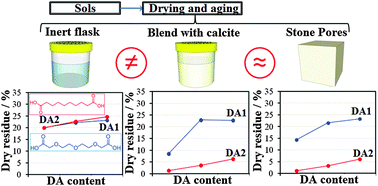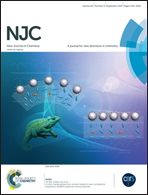Development of formulations based on TEOS-dicarboxylic acids for consolidation of carbonate stones†
Abstract
This work aims at developing a novel TEOS-based solution for stone consolidation. By optimization of the sol–gel parameters and modification of the silica structure with two dicarboxylic acids with distinct central chains, several sols were produced. The experimental methodology included the characterization of xerogels, the study of sols' behavior when blended with calcite powder, the main component of carbonate stones, and when applied on limestone by capillary suction. The results revealed that 3,6,9-trioxaundecanedioic acid (TUDA) was homogeneously distributed inside the silica network, while sebacic acid (SA) was segregated on the xerogel surface (except for the sols containing the lowest molar fraction of SA). When the sols were blended with calcite powder, the dicarboxylic acids were chemically incorporated into the silica network, as confirmed by 29Si-NMR. The results demonstrated that the presence of calcite has a strong influence on the sol–gel route and consequently on the properties of the final products. The presence of calcite also enabled the incorporation of dicarboxylic acids within the silica network. This work highlights the relevance of studying the properties of xerogels produced in inert flasks and also stresses the importance of studying the products derived from sol–gel reactions conditioned by chemical environments comparable to the ones existing in the stone’s pores. Thus, this work revealed new insights that can explain either failures or success cases related to the application of alkoxysilane based consolidants in carbonate stones.


 Please wait while we load your content...
Please wait while we load your content...